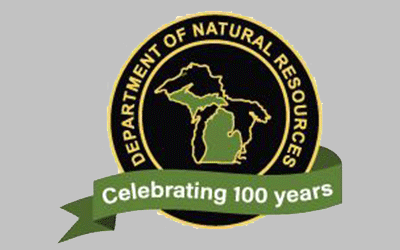May 28, 2021
Contact: Steve Milford, 989-732-3541, ext. 5040
So why are those trees being cut down? It’s part of good forest management
 Visitors to the Grayling area this summer will notice some spots in the woods where trees have been cut down on state-managed land near trails and roadways. Visitors to the Grayling area this summer will notice some spots in the woods where trees have been cut down on state-managed land near trails and roadways.
The clearcuts may be unsightly for a few seasons, but they’re an important part of the process the Michigan Department of Natural Resources uses to manage 3.9 million acres of state forest and keep forests thriving well into the future.
“We cut trees for a lot of different reasons. It’s part of good forest management. It can be for the health of the forest, to provide wildlife habitat, or to regenerate stands that are aging,” said Steve Milford, manager of the Eastern Lower Peninsula District of the DNR’s Forest Resources Division. Trees being cleared by timber harvesters in that area include jack pine, red pine and hardwoods such as oak. |

Cutting may remove trees more susceptible to disease and open views along trails
Clearcuts also take place for other purposes. For example, jack pines in the area are strategically cut to maintain nesting sites for the Kirtland’s warbler, a once-endangered songbird that will nest only on the ground under the shelter of young, shrub-like jack pine trees.
Another clearcut area that will be noticeable is within the historic Higgins Lake State Forest Nursery, which is the beginning of the North Higgins Lake State Park hiking trail system. The seed bed grounds, which are state park lands managed as a museum by the Michigan History Center, were overgrown with invasive black locust trees. When the nursery started operating in 1903, there were fewer trees on the landscape because much of northern Michigan had been clearcut for lumber. The nursery produced millions of seedlings to reforest large portions of the state.
“Forest habitats change over time,” said Kristen Bennett, acting statewide trails coordinator for the DNR’s Parks and Recreation Division. “Over the course of 10 or 20 years, your favorite trail or camping site may have changed in small or big ways.
“Resource management decisions consider a variety of factors in the level of action to take. At times, the action is to monitor and let the natural process work. At other times, there is intensive management through cutting and replanting. The DNR divisions work closely together to make sure that forest health and recreation are both considered in the process.”
The areas that have been cut will remain managed forest land and are not being cleared for development. The forest is intended to be replanted or undergo natural generation from nearby seed trees.
DNR is certified in sustainable forest practices
The DNR is certified by two independent agencies that promote sound forest management. In addition, public input is always welcome. You can find an interactive state forest map and learn more about state forest management plans at Michigan.gov/ForestManagement. Comment periods are open through the summer for management plans including cutting, prescribed burning and more to be carried out in 2023.
Note to editors: Accompanying photos are available below for download. Caption information follows.
Clearcut: Clearcuts can be shocking for people who are used to seeing an unbroken stand of trees, but this important forest management tool can benefit forest health, wildlife habitat and more. This red pine clearcut is in Beaver Creek Township in Crawford County and is scheduled to be replanted.
Lake view: Removal of aging and non-native trees along this trail in conjunction with an Iron Belle Trail surfacing project has opened up a view of Higgins Lake in the distance. |








 Visitors to the Grayling area this summer will notice some spots in the woods where trees have been cut down on state-managed land near trails and roadways.
Visitors to the Grayling area this summer will notice some spots in the woods where trees have been cut down on state-managed land near trails and roadways.
